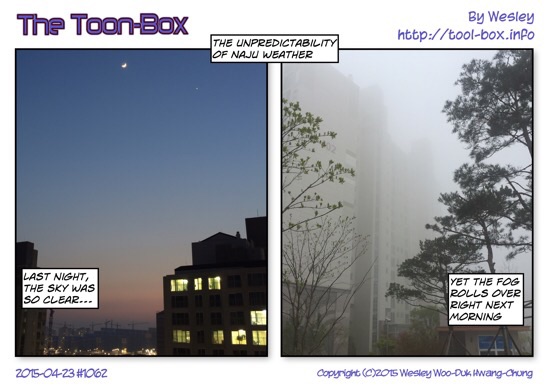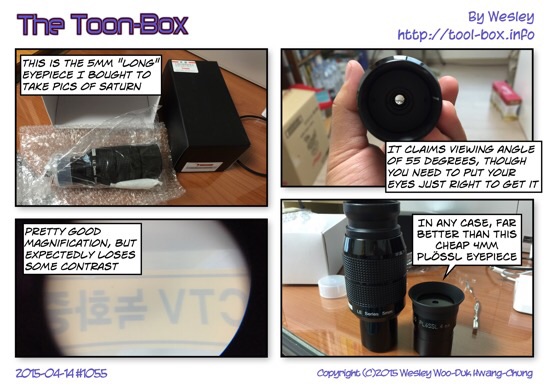Entries tagged as astronomy
camera Moon Sanyo VPC-C4 satellite Minolta Dimage X20 binoculars Chuseok telescope eclipse Kodak Z1085 IS star Sun iPhone 4 A1533 iPhone 5S slow motion A1530 LTE iOS iPhone 4S sound Celine Chung electric fan LED light trail M&M's A1524 iPhone 6 Plus OIS Cortex Camera Focus Pixels A1522 A1549 A1586 barometer belt case iOS 8 iPad iPad mini iPhone 3GS iPhone 5 iPhone 5C iPhone 6 KT LGU+ Canon SX50 HS ISS Canon EOS 450D planet Venus Alhena constellation Iridium Jupiter Orion Mars China Korea lunar calendar Bushnell 8x40 fog Naju iPhone 7 Plus Bitgaram City Sony A5000 beach firework Ulsan Nikon CoolPix P1000 almond nuts walnut flare MetOp-A Ursa Minor KPX Celestron NexStar 6SE Snapzoom asteroid Josephina Neptune Triton Saturn teleconverter duck Hayun Chung river Sung-Eun Kim Yeongsan cafeteria ice persimmon Korean dress rice cake beverage chocolate HT-Mini v2 toy dwarf planet Pluto Jeonnam Science Festival Messier 11 Messier 2 adapter iPhone 6S Plus artificial star collimation Andromeda focal reducer galaxy iPhone 11 Pro Singapore travel Uranus Hiroshima iPhone 16 Pro Japan Lyra airplane Boötes Leo Minor Ursa Major Bode's Galaxy Cigar Galaxy iOptron SkyTracker Ceres Heze Vesta Zeta Virginis C/2014 Q2 Lovejoy comet nebula Taurus road shade cat assembly kit car cup Starbucks Bolt EV electric SpaceX electric vehicle Sight Knight visor Jeonju iPhone 13 Pro Gunsan space station Tiangong 3DMark Geekbench Octane SunSpider Touch ID battery PeaceKeeper charger box iPhone 6+ iPhone 7 Raynox DCR-1540PRO Vivitar 2.0X lightning C/2013 R1 Lovejoy CHDK Nikon D3300 Samyang Polar 800mm Toast TP-2 Milky Way iPhone X meteor shower Perseids Scorpius cable magnet Micro-USB USB Apple Watch Bluetooth GPS pen dock earphone speaker rain satellite TV shower television water apple Seoul shopping Yongsan iOS 13 memory MicroSD storage card reader mouse electricity Goheung Naro Space Center Dragon expressway parking lot service area Boeing Daejeon international spacecraft AT&T SK Telecom fingerprint sensor M7 pedometer Kraken performance accelerometer compass gyroscope Han-gang passcode Kiwi Fotos KF-8012N smog COEX Samseong skyline subway contamination Heathrow Airport London Wesley Woo-Duk Hwang-Chung anchovy snack airport Gimpo Lotte World Seoul National University kids cafe Lego Petit Monde instant noodles ramyeon Africa Benin gas station toll gate game Korean Air cloud Asiana Airlines Coca Cola emergency soda Tokyo building Bode’s Galaxy Sombrero Galaxy light fixture iPhone XS Christmas tree decoration balls lights sled snow screwdriver table cookie milk Oreo Homeplus pizza chocolate chip cookies couch FaceTime New Year's Day Skype tteokguk computer swing Toys R Us trampoline Mega Kids Box Megabox movie theatre tortilla wrap toothbrush salad Disney Frozen remote controlled helicopter repair replacement Syma S107G Danish butter cookies animation Larva shopping cart ball bed globe headphones pink breakfast rice porridge Lunar New Year traditional Korean dress Hyung-Bae Kim kite sausage Cloud Cuckoo Palace Princess Unikitty The Lego Movie Evil Robot playground slide dinosaur InoQ Tyrannosaurus 3D printing hot-end Makibox squirrel bunny balloon Jenga 123D Design Autodesk coin Electric Love Marathon heart Tayo Christmas Octonauts play set present apple tree Financial Museum Kwangju Bank vegetable Pop Up Pirate Anna Elsa Gwangju princess
Today's "The Toon-Box"
Posted by Wesley onBig Saturn shots with 5mm eyepiece
Posted by Wesley on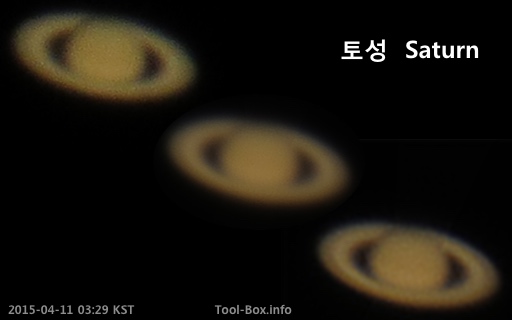
Biggest photos of Saturn from SX50 HS yet
[Raw - Stacked - Wavelet Processed]
[Raw - Stacked - Wavelet Processed]
Hoping to get a bigger look at the planets, I bought a 5mm LE series eyepiece from e.Frantis. It would supposedly get twice the magnification of the 25mm eyepiece & 2.5x barlow lens combination. After waiting for more than a week for the weather to clear up, I observed the planet Saturn through the brand new eyepiece. It certainly showed the planet nicely, in spite of being a bit dark due to the high magnification.
Not to miss the opportunity to capture this on camera, I got my SX50 HS camera out and placed it over the eyepiece by hand. After several hundred shots, I was able to recover a handful of good photos. Putting them together, I was able to finally have the Cassini Division on the rings of Saturn properly show up. This fulfilled one of the main expectations I had of the Celestron NexStar 6SE telescope.
As for the actual magnification of the eyepiece, my calculations showed that the photos had a 0.22 arc second / pixel resolution, which is about 6.65 times better than the 50x zoom provided by SX50 HS's integrated lens. This is equivalent to having a 8000mm zoom lens. Also, this is 2.4 times the magnification given by the aforementioned eyepiece-barlow lens combo. This is somewhat higher than expected.
Telescope: Celestron NexStar 6SE + 5mm eyepiece
Device: Canon SX50 HS (afocal)
Settings: 24mm - ISO 200 - 1/5s - f/3.4
Filters: None
Time: 2015-04-27 03:16-03:29 KST
Location: Naju, Korea
23 photos stacked with RegiStax 6.1.0.8
Defined tags for this entry: astronomy, Canon SX50 HS, Celestron NexStar 6SE, planet, Saturn, telescope
First good Jupiter shots from NexStar 6SE
Posted by Wesley on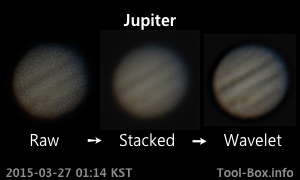
Getting sharper image of Jupiter from SX50 HS without using integrated zoom
After fixing the collimator screw problem, I spent some time getting my Celestron NexStar 6SE properly collimated. To see if this improved the sights, I pointed the telescope to Jupiter. Sure enough, I could see the details of the clouds on the surface much better. I could even make out the Great Red Spot.
I wanted to capture this on camera, so I attached my Canon EOS 450D DSLR directly to the telescope tube for some prime focus astrophotography. But for reasons I still haven't figured out yet, the photos couldn't resolve any details - the planet was just a yellowish disc. I'd have to take photos of the Moon to see what's going on in the coming days.
Still, I didn't want to waste a good sighting opportunity, so I pulled out my usual astrophotography gear, SX50 HS, and took the photos of Jupiter through the eyepiece and the barlow lens attached to the Celestron NexStar 6SE without using the optical zoom. This yielded a pretty good result, especially considering that I just held the camera up the eyepiece by hand. The disc is also about 2.75 times the diameter compared to what would've been possible with the camera's integrated 50x zoom (0.53 vs. 1.46 arc seconds).
Telescope: Celestron NexStar 6SE + 25mm eyepiece + 2.5x barlow
Device: Canon SX50 HS (afocal)
Settings: 24mm - ISO 80 - 1/80s - f/3.4
Filters: None
Time: 2015-03-27 01:14 KST
Location: Naju, Korea
Defined tags for this entry: astronomy, Canon SX50 HS, Celestron NexStar 6SE, Jupiter, planet, telescope
Removing stripped collimator screw
Posted by Wesley on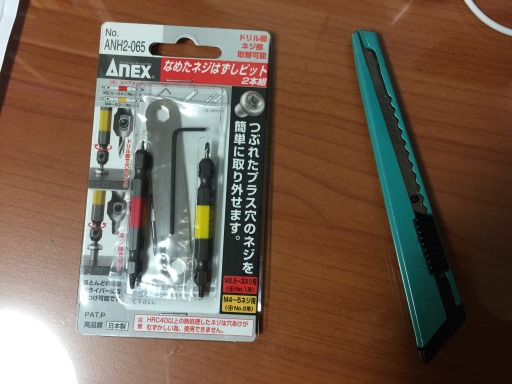
Anex ANH2-065 stripped screw extraction kit
I've mentioned earlier that one of the collimator screws on my Celestron NexStar 6SE telescope was completely stuck, preventing proper calibration. It was so bad that the screw's head became stripped in the attempts to unscrew it, and pliers were of no use, either. To fix this problem, I ordered Anex ANH2-065, a stripped screw extraction kit made in Japan for US$20. It had a lot of favourable reviews, so I thought I might as well try it.
The kit came with two drill bits, one for working with 2.5 to 3mm screws (red) and the other, 4 to 5mm screws (yellow). One end of each bit is used for drilling a small hole in the middle of the screw and the other end is a reverse-threaded tap that gets inserted into this hole. As you turn the bit counter-clockwise, the tap burrows into the screw. Eventually, the screw is supposed to turn with it and come out.
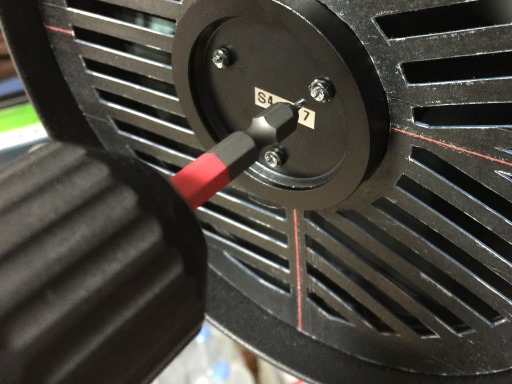
Insert the drill bit into stripped screw
NexStar 6SE's collimator screw is the same one used with C6, an M3 (3mm) type with 12mm length, so I got my old cordless drill charged up and inserted the red bit. I set the torque level to low to reduce the risk of damage, and carefully drilled out a tiny hole about 4mm deep into the stuck screw.
